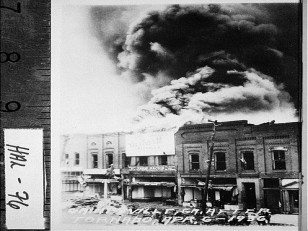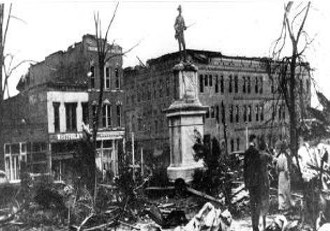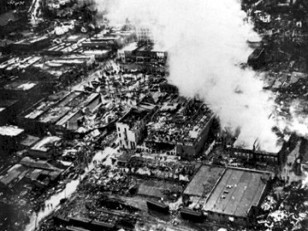GAINESVILLE - It was 75 years ago Wednesday that a massive tornado laid waste to downtown Gainesville, killing more than 200 people and injuring 1,600.
Jim DeLong, a junior at Gainesville High School at the time, was uninjured, as was a friend who was with him, George Austin, a 14-year-old sophomore at GHS. The pair were neighbors on Green Street. Both lived in an area near Green and Candler streets. Austin had spent the night with DeLong because his parents were out of town.
Both remembered that there was not much unusual about that spring morning as they prepared for school. It was warm and muggy, but the skies did not appear especially threatening. But a storm system that had spawned a tornado that killed about 200 in Tupelo, Mississippi, the night before was just minutes away from Gainesville.
Austin, a retired Army colonel and former director of public works for the City of Gainesville, now deceased, and DeLong, a retired automobile dealer, recalled that fateful morning in an interview with AccessNorthGa.com in December 1999 for a series of stories on events of the 20th Century that had a major impact on Gainesville and Hall County.
They had walked through the square and were near Maple Street, when they realized the weather was turning terribly bad.
"I first noticed the trees, swaying in the wind, and then I saw, or maybe I heard, one being twisted from its roots," Austin recalled. "That's when I knew something bad was coming."
The two friends turned and ran back toward town, though they were almost within sight of their school, which stood at the corner of Washington and Academy, across from Peach State Bank.
They said they were looking for shelter from the storm, but the first two store doors they tried were locked because, DeLong said, "it wasn't nine o'clock yet and they weren't open." But one of their favorite hangouts, Imperial Pharmacy, with the "five-cent milkshakes," Austin recalled, was open.
Austin and DeLong said they ran through the door and dove over the counter with other people as the twister descended on the square. They remembered the store's door being blown out, but the roof and the walls held as the storm roared through town.
When it was over, they went outside.
"I think I was the first one out," Austin said, "and the first thing I saw was a pig wandering around the Civil War monument. I don't think anyone knows where it came from." And, he said it was "deathly quiet." DeLong said you could hardly walk across the downtown square because of the debris. "There was tin and wood and other debris [all over the place]."
Each said there was no immediate sign of the deadly fires that broke out in the wake of the tornado, just destruction everywhere. But, soon those signs became evident. One was in the Cooper Pants Factory where around 70 people - perhaps 125 by some estimates - died.
Neither lost any relatives in the storm but each had friends who were killed.
DeLong said it wasn't long before help from the outside began arriving. Someone, he said, made it to the railroad depot and found a working phone and called the Atlanta Journal-Constitution and asked people there to call the governor and tell him what had happened.
Both recalled that in the days after the storm they helped ferry bricks, which arrived by the boxcar load, from the depot to downtown. DeLong said his father, who was in the automobile business, had a "GMC flatbed truck" which "we used to haul bricks to town." He said some of the bricks used to rebuild the city are still visible on the Washington Street side of the building now housing Saul's.
"Everybody pitched in," DeLong said, "in helping."
Austin felt certain that if such a storm were brewing today that many lives would be saved "because people would have ample warning and would be able to get to a safe place" before it struck. He said it was not until after the twister that he learned the Imperial Pharmacy, in which he and DeLong sought shelter, had a basement.
DeLong said if anything good came out of the twister it was that many badly-constructed and dilapidated buildings and homes that were destroyed or severely damaged were rebuilt with better materials, using better construction methods.
The 1936 tornado was not the first to cause a massive number of deaths in Gainesville. About 100 people also died in the early part of the century when a tornado struck another part of town. In addition, a number of far, far less severe twisters have hit the Gainesville area since then, the most deadly in 1998 in the North Hall area. That was also an early morning storm and, despite the advances in warning systems, it struck without warning, killing 12 people in that part of the county.
The Northeast Georgia History Center, which has a permanent exhibit about the 1936 tornado, will host a reception Wednesday from 5:30 until 7:00 p.m. commemorating the anniversary of the deadly storm. At 8:15 Wednesday morning, a plaque will be unveiled on the downtown square.
Perhaps one of the most poignant images of the tragedy is a picture of a clock in the downtown area at the time. It's hands are frozen in time... at 8:27, the time full fury of the storm apparently struck, leaving behind "a city laid waste."
The aftermath of the tornado was well-documented in photographs. (See accompanying pictures and click on the link below for a slideshow of pictures taken after the storm.)
(EDITOR'S NOTE: Starting Monday on the Bill & Joel Morning Show on WDUN NEWSTALK 550 and continuing through Wednesday, you can hear, in their own words, what George Austin and Jim DeLong experienced. A series of three special reports will be broadcast each morning during the 5:30 newscast and repeated duirng the 6:30 and 7:30 newscasts. In addition there will be special programming all day on WDUN - on the morning show, the Al Gainey Show and the Afternoon Show with Georgie and BJ - dealing with the tornado. Included will be interviews with other survivors of the storm. And, a special video will be presented on AccessNorthGa.com starting Wednesday morning at 6:00 and running continuously all day.)
Monday
June 2nd, 2025
8:51AM











